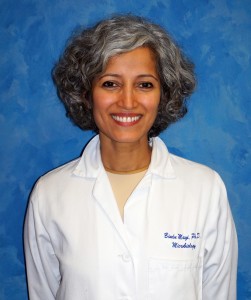NSU Newsroom
SharkBytes
Horizons
This version of NSU News has been archived as of February 28, 2019. To search through archived articles, visit nova.edu/search. To access the new version of NSU News, visit news.nova.edu.
This version of SharkBytes has been archived as of February 28, 2019. To search through archived articles, visit nova.edu/search. To access the new version of SharkBytes, visit sharkbytes.nova.edu.
Let’s Stay Healthy: Food Safety Tips for the Holidays
Bindu S. Mayi, M.Sc., Ph.D., professor of microbiology at NSU’s College of Medical Sciences educates people on how to stay healthy and safe during the holiday season.
As we approach our biggest holidays of the year, it is worth remembering that one in six Americans could get sick from food poisoning this year alone! The CDC estimates that each year, 3,000 people could die from eating or drinking contaminated foods or beverages. Once the initial symptoms are gone, food poisoning can also cause long-term health consequences like kidney disease, arthritis and other conditions. Foodsafety.gov has actually broken down food safety into 4 easy steps: 1. CLEAN 2. SEPARATE 3. COOK 4. CHILL
CLEAN
There is a RIGHT way to clean hands – 20 seconds with plain soap and running water. Scrub your palms, the backs of your hands, in between fingers and underneath your fingernails!
Clean hands before
preparing food, eating food, feeding bottles or foods to an infant or toddler, touching an infant or toddler’s mouth, touching pacifiers or other things that go into an infant or toddler’s mouth
Clean hands after
using the bathroom, changing diapers, preparing food, handling uncooked eggs, or raw meat, poultry, seafood, or their juices, touching our pets, handling pet food, touching animal waste, contacting animals or their environments such as at farms, petting zoos, etc.
If you don’t have access to soap and water, use an alcohol-based hand sanitizer with 60 – 95% alcohol. A good rule of thumb is also to not prepare food or drink for others when we are sick. In addition to hand hygiene, we have to clean kitchen counters, cutting boards and utensils.
Do we wash the food itself?
Some foods, yes. Wash fruits and veggies under running water, even if you plan to peel them. Fruits and vegetables labeled “prewashed” do not need to be washed again at home. Do not wash raw meat and poultry as their juices may splash onto your sink and countertops and contaminate those areas with bacteria that can cause food poisoning. Commercial eggs are washed before they are sold. Any extra washing may increase risk of cross-contamination, especially if the shell becomes cracked.
SEPARATE
Store raw meat, poultry, or seafood below and separate from fruits and vegetables. If you don’t have a meat drawer, use a clear plastic bin to store your meat. Any potential leakage of fluids can then be contained within the bin or the meat drawer and prevent cross contaminating other foods. The same rule of separation applies when shopping for groceries. Keep your meats separate from your fruits, veggies and other ready to eat items.
While cooking, use a cutting board that is reserved just for raw meats, poultry, or seafood. Use a separate cutting board for fruits and veggies. Any cutting boards used for raw meats, seafood etc. should be cleaned immediately after use with hot, soapy water. Avoid raw milk, other unpasteurized dairy products, and unpasteurized juices as these could harbor harmful bacteria.
COOK
Bacteria that can cause food poisoning grow really well in the temperature between 40F and 140F. Our refrigerator temperature should be 40F or below, which means when we store our foods, the cold temperature will stop bacteria from growing on our foods. When we serve foods, we have to remember to keep hot foods hot, at 140F or warmer, with the help of chafing dishes, slow cookers or warming trays. This brings us to the appropriate cooking temperature for different foods. Let’s break this down into easy steps:
- Use a food thermometer.
- Keep food hot after cooking (140F or above), unless you are going to store it, in which case see the section CHILL below.
- Refer to the list on url below to learn about safe cooking temperatures. https://www.foodsafety.gov/keep/charts/mintemp.html
CHILL
It is a good idea to refrigerate perishable food within 2 hours and within 1 hour when the temperature is greater than 90°F. Although, it is ok to put hot foods directly into the refrigerator, it is a good idea to divide leftovers into smaller portions or pieces, place in shallow containers, and then either refrigerate or freeze.
We see food borne infections due to a breakdown in one or more steps in the FOUR steps to food safety. Some people are at higher risk of food borne illnesses and these include pregnant women, newborns, children, older adults, immunocompromised individuals and those with chronic medical conditions (like diabetes, HIV etc.). I hope you will follow these simple steps to clean and safe food preparation, serving and consumption. Although it is too early to say Happy Holidays, I hope you will have a Healthy and Happy rest of the year.
